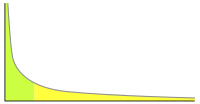James asks, "What does "long-tailed" mean?"
The "Long Tail" is the right-hand side of a graphed power law function, which emerges when a few items have a high value and many many items have a low value. Think of sales of popular music or books, or frequency of words in written English.
More to the point, think of Amazon.com vs. Wal-Mart's book section. Because inventory costs are low, Amazon can afford to sell very infrequent copies of rather obscure books - those that occupy the Long Tail. Low inventory and delivery cost means the threshold for commercial viability is drastically lower and more creators can get a (tiny) slice of the action.
Tuesday, April 22, 2008
The Long Tail
Labels:
commerce
By
Scott Hanley
![]()
![]()
Subscribe to:
Post Comments (Atom)


3 comments:
Thank you. I was thinking it must be something along those lines, but I didn't have the idea very clear in my head.
It really is a business cost issue. Besides the cost of inventory, the cost of per-copy "printing" (which I suppose must include electronic copies nowadays) has, and will continue, to come down. Or, in old-fashioned non-tech talk, niche markets will become increasingly viable. Hooray, hooray.
"[N]iche markets will become increasingly viable."
That's a good way of summing up the consequences. One other point - those niche markets become viable for the mainstream merchants to move in on. Not so good for the seller of rare books, but much easier on the buyer.
"Not so good for the seller of rare books, but much easier on the buyer."
All good, from an economist's perspective. Free markets are all about the benefit of consumers, not businesses.
Post a Comment